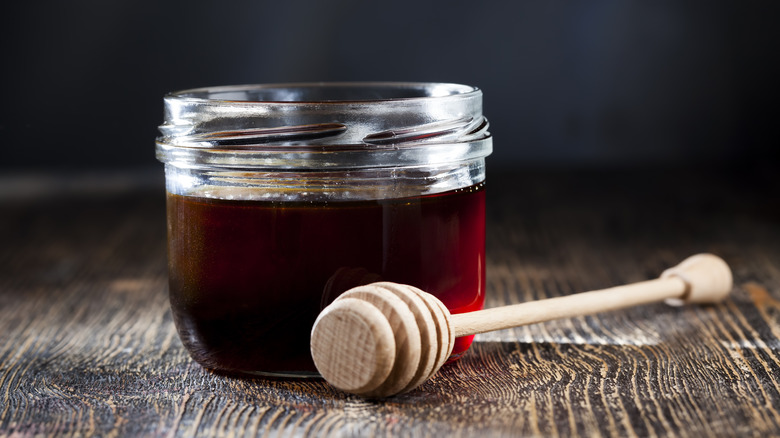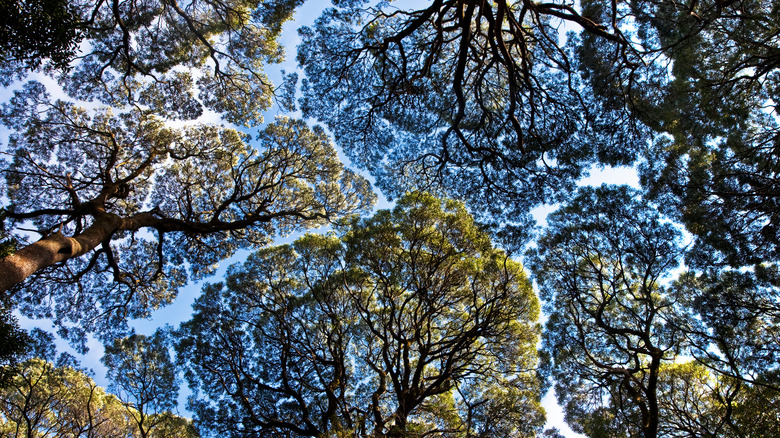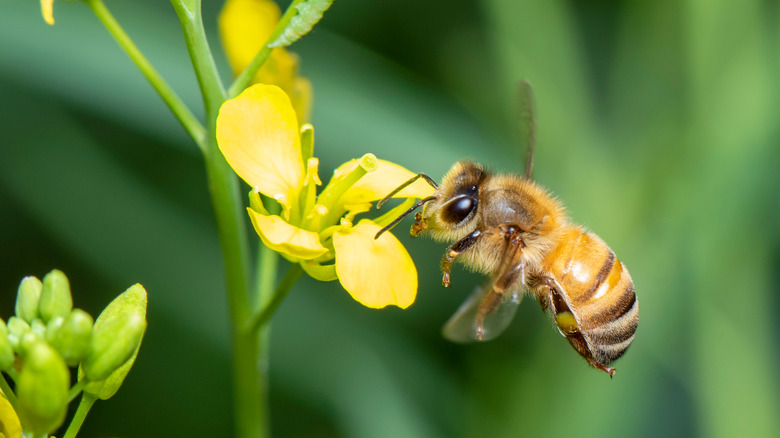Bees Can Get Helicopter Rides To Make The World's Best-Tasting Honey
Winnie the Pooh might want to avert his eyes because we're going to explain how honey is made, and it's kind of gross. According to Live Science, honey is made by female worker bees who gather nectar from flowers and store it in a special honey stomach. Once the stomach is full, the bee returns to its hive, reuniting with other workers. Now comes the really nasty part, as the bees line up and regurgitate the contents of their honey stomachs, passing the mixture from one mouth to the next, gradually reducing its moisture content to achieve the viscous texture we're so familiar with. Finally, they dump the honey into the hexagonal cells of the beehive to save as a long-term food source. Yum!
As you've surely noticed, honey comes in many colors and flavors. Per Britannica, these differences are due to the type of flower from which the bees collect their nectar. When the nectar is derived from a very particular source that only exists in a limited geographic region, it can drive the price of the honey to shocking heights. A well-known example is manuka honey, sourced from Australia and New Zealand, a single jar of which costs a whopping $80 at Whole Foods. But there's another type of honey from an adjacent region that is rarer than manuka but not as well known. Finding the nectar for leatherwood honey is so difficult that some companies are even airdropping bees into remote rainforests just to get a taste.
What makes leatherwood honey special?
Leatherwood honey is made by bees who feed on the nectar of flowering leatherwood trees in Tasmania, a small island state that forms the southernmost part of Australia. Contrary to the popular perception of Australia as the land of the arid Outback, Atlas Obscura notes that Tasmania is home to a temperate rainforest, giving it unique environmental conditions where leatherwood can flourish. The honey made from this nectar has a very strong taste with a sharp and savory flavor profile that no other variety shares. Long considered to be an acquired taste, leatherwood honey got a major boost in 2015 when the Apimondia International Apicultural Congress named it the world's best-tasting honey (via The Mercury).
Before the landmark award, the dark and musky leatherwood honey was unpopular in many circles. It was sometimes used as a filler to be mixed with other, more 'desirable' types of honey, per Broadsheet. However, changes in the way honey is processed have made a major impact on its flavor profile, and cold processing gives the stuff a floral and somewhat spicy taste. The honey is also a critical resource for Tasmania's bee population because leatherwood is the one type of tree that reliably produces flowers each year. Other varieties exist in Tasmania, but the climate, much colder than that of Australia's mainland, means that most trees don't flower on an annual basis. Unfortunately, leatherwood is becoming a less reliable resource itself, which has led some beekeepers to get creative.
Flight of the honeybee
Tasmania's leatherwood trees face mounting dangers related to climate change. STEP Inc, an Australian environmental activist group, warns that drought and rising heat levels pose a particularly serious threat to Tasmania's rainforests. Recent wildfires have resulted in the widespread loss of leatherwood trees. Bee Culture also raises concerns about the logging industry, noting that leatherwood trees are considered a valuable source of timber. Clear-cutting vast areas of leatherwood trees has steadily decreased the amount of nectar available to bees. Beekeepers are forced to transport their hives to ever more remote regions of Tasmania if they want to access healthy leatherwood trees. How do they manage to get them into such isolated areas? By helicopter, of course.
Lindsay Bourke, the same beekeeper whose honey was named the world's best by Apimondia International, commissioned a helicopter pilot with a custom-built rig to airlift hundreds of beehives into a remote spot in the rainforest where their residents could access flowering leatherwoods (via the Australian Broadcasting Corporation). Other beekeepers have joined Bourke, and the effort has even been replicated in other parts of the world. Remember that expensive manuka honey we mentioned earlier? Starting in 2020, Egmont Honey of New Zealand began flying their hives to remote parts of the island in search of fruitful trees. It's an entertaining bit of innovation, but the forces driving it, namely the scarcity of environmental resources, remain a serious concern.


